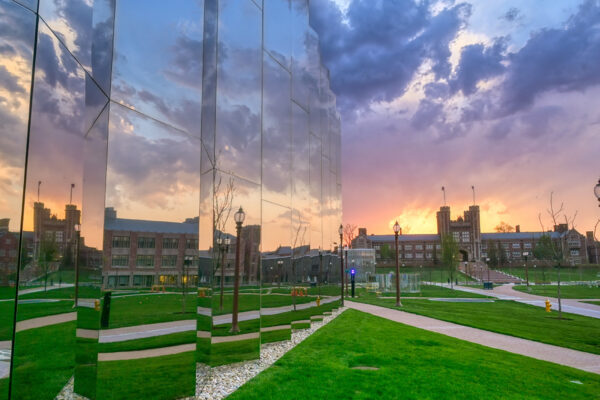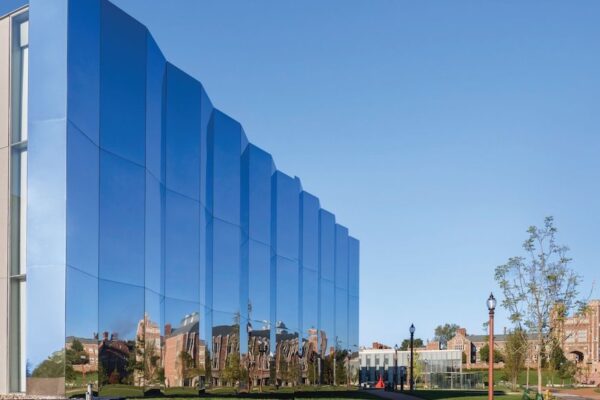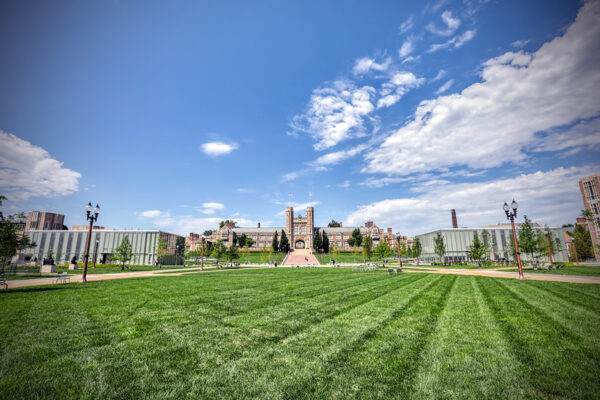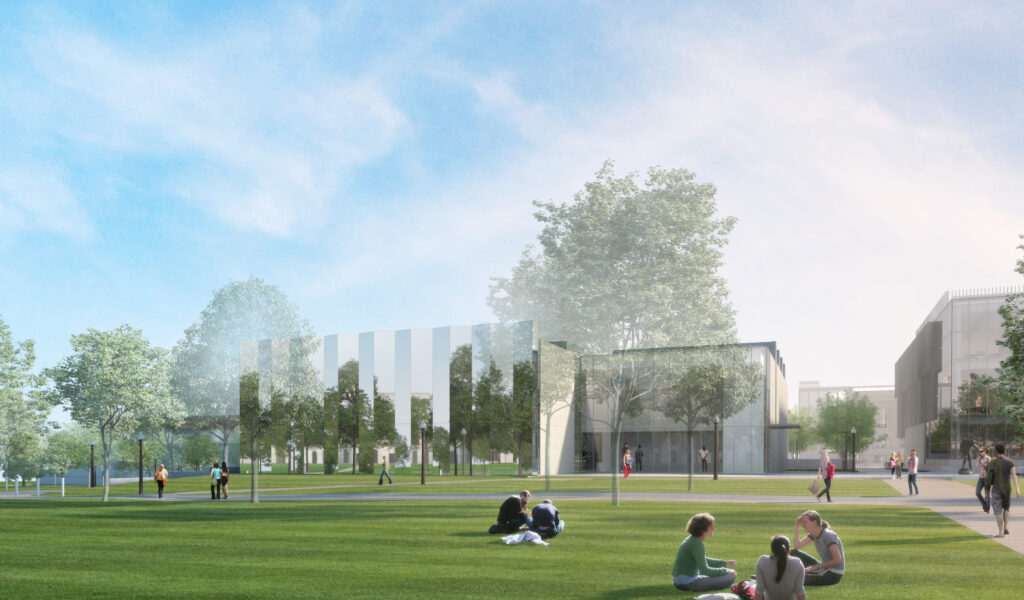
This fall, one of the top programs for art, architecture and design at a U.S. university — the Sam Fox School of Design & Visual Arts at Washington University in St. Louis — will unveil two major new capital projects that will transform the campus, reshape the visitor experience and firmly establish the prominence of its art museum on campus. The newly constructed Anabeth and John Weil Hall will house state-of-the-art graduate studios, classrooms and digital fabrication spaces. A major expansion and renovation of the Mildred Lane Kemper Art Museum will strengthen visibility, better showcase the renowned permanent collection and accommodate larger and more varied special exhibitions.
Designed by the internationally acclaimed architecture firmKieranTimberlake, both projects are part of the $280 million transformation of the East End of WashingtonUniversity’s Danforth Campus, which broke ground in 2017. The renovated Kemper Art Museum will open to the public on September 28. A dedication for the larger East End transformation, which encompasses eight components, will take place on October 2.
“This is the dawn of a new era for Washington University and the Sam Fox School,” said Carmon Colangelo, the Ralph J. Nagel Dean and E. Desmond Lee Professor for Collaboration in the Arts at the Sam Fox School. “Weil Hall and the expanded Kemper Art Museum demonstrate the important role that art, architecture and design education play within a top-tier private research university.
“For the first time in decades, all of our graduate and undergraduate art, architecture and design programs will be located together at the front door to campus,” Colangelo said. “Students will enjoy innovative new studios, share interdisciplinary common spaces and engage with our world-class art museum on a daily basis. But most importantly, they will inspire one another and more easily collaborate across disciplinary boundaries.”
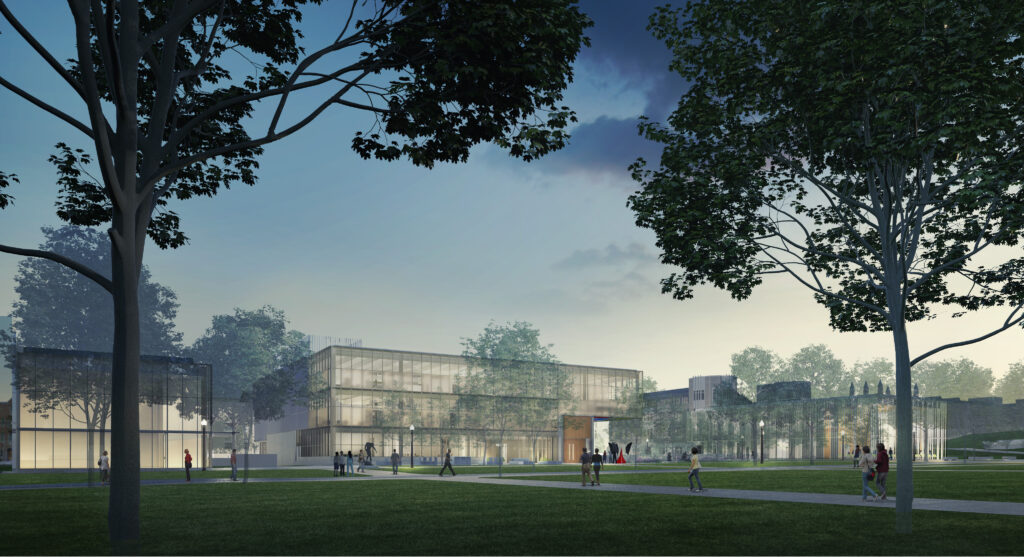
Weil Hall: Community and Dialogue
With its ambitious design and open, collaborative program, Weil Hall represents a physical manifestation of core Sam Fox School traits. Formed in 2006, the Sam Fox School offers a unique academic structure, at once unified and collaborative, for professional art, architecture and design education. Students and faculty explore contemporary global design issues—from environmental resiliency to diversity and social equity to the power of cultural expression and the enduring values of the arts—through teaching, research, exhibition and community engagement.
Weil Hall, with its abundant natural light and flexible, loft-style studios and workspaces, will be a new locus for teaching, study, creation and critique. Within the new building, the William A. Bernoudy Architecture Studio, along with studios for graduate architecture, landscape architecture, urban design and visual art, will house programs for the Graduate School of Architecture & Urban Design and the Graduate School of Art. Over the last decade, both graduate schools, which include the nationally ranked Master of Architecture and Master of Fine Arts in Visual Art programs, have doubled in size. The Roxanne H. Frank Design Studio will house the Graduate School of Art’s new Master of Fine Arts in Illustration & Visual Culture program, which welcomes its first class in fall 2019.
Another component of Weil Hall, the luminous, two-story Kuehner Family Court, will feature a living green wall, skylights, and glass walls that allow for visual connectivity between studio spaces, providing students with a feeling of simultaneity and participation in a larger community. As the conceptual heart of the building, the Caleres Digital Fabrication Studio will allow students and faculty across programs to execute complex projects using state-of-the-art tools. Other notable spaces will include the Ralph J. Nagel Dean’s Suite and Weil Hall Commons, which will include a commissioned mural wall that will feature new works by alumni each year.
“The design of Weil Hall is about fostering intentional interaction among disciplines in a flexible, open,
light-filled space that inspires scholarship, creative research and bold experimentation,” says James Timberlake of KieranTimberlake. “This was an opportunity to give new life and purpose to the Danforth Campus by putting the vitality of the art and architecture programs on view front and center for all to see.”
Weil Hall joins the Sam Fox School’s stately, Beaux Arts-era Bixby (1926) and Givens (1932) Halls; the modernist pavilion Steinberg Hall (1960); and the limestone-clad Walker Hall and Mildred Lane Kemper Art Museum (both 2006). The latter three were designed by Pritzker Prize winner Fumihiko Maki, a former member of the architecture faculty.
KieranTimberlake designed Weil Hall’s sleek glass exterior to create a rich dialogue with the color, form and proportions of all five earlier buildings. An elegant facade of opaque and translucent glass with vertical aluminum fins affords generous natural light throughout the interior and access to striking campus views while minimizing solar gain and glare inside the building.
“With its graceful forms, research-driven design and thoughtful approach to site and environmental responsibility, Weil Hall provides our students with a powerful example of how architects can address today’s most critical questions,” said James Kolker, Washington University architect and associate vice chancellor. “KieranTimberlake’s design models the very skills and values that the Sam Fox School works to impart, and adds a fresh chapter to Washington University’s historic campus.”
Expanded Kemper Art Museum: Wider Reach, Deeper Engagement
A striking new 34-foot-tall polished stainless-steel facade will draw visitors to the expanded Kemper Art Museum where public display space will increase by nearly 50 percent. The building’s pleated surface will reflect the dynamic movement of campus and sky while sparking curiosity and inviting interaction. It will set the stage for both the outstanding collection and the thought-provoking exhibitions to be experienced within.
Known for its persistent exploration of intersections between art, politics and everyday life, the Kemper Art Museum is unique among university institutions for the superb quality of its modern and contemporary holdings. In the mid-1940s, famed art historian H.W. Janson, an exile from Nazi Germany, acquired iconic artworks by Pablo Picasso, Max Beckmann and Max Ernst, among many others. In the 1950s and ’60s, Frederick Hartt and William Eisendrath Jr. added major pieces by such artists as Jackson Pollock, Willem de Kooning, Antoni Tàpies and Lucio Fontana.
Since 2005, Sabine Eckmann, the William T. Kemper Director and Chief Curator,has turned the museum’s focus to a diverse array of modern and contemporary figures like Arman, Marcel Duchamp, Thomas Demand, Isa Genzken, Alfredo Jaar, Rashid Johnson, Julio le Parc, Gary Simmons and Carrie Mae Weems.
“Our mission is to engage today’s most challenging artistic concerns through the work of contemporary international artists, and to explore global histories of modern art that have not yet been told,” Eckmann said. “Janson’s bold vision established the museum’s long-term trajectory. The current expansion represents a similarly transformative moment. It will enable us to reach larger and more diverse audiences and to deepen our exhibition and collecting programs while reflecting an even broader array of both modern and contemporary artistic practices.”
The museum will reopen Sept. 28 with “Ai Weiwei: Bare Life,” a thematic exhibition that will offer new insight into the celebrated Chinese artist’s work on human rights and his deep engagement with China’s past — from the rupture of the Cultural Revolution to the radical shifts that have characterized the new millennium. On view through Jan. 5, 2020, the exhibition will feature nearly 40 artworks, many in series, created in a wide variety of media over the last two decades. Highlights will include several new large-scale projects created for this exhibition as well as works never before exhibited in the United States.
Entering the museum, visitors will encounter a soaring new glass-lined lobby. Suspended overhead will be a dramatic new installation by artist Tomás Saraceno (whose work the museum surveyed in 2012), a network of iridescent modules and interconnected ropessuggesting a utopian vision of life in the sky. The new 2,700-square-foot James M. Kemper Gallery, with its double-height walls, will showcase a range of post-war and contemporary art. On the second floor, the reconfigured Gertrude Bernoudy Gallery will provide an intimate viewing experience for major 19th- and early 20th-century European and American works.
Other renovations — led by Escher GuneWardenaArchitecture in partnership with Trivers—will include a first-floor coffee bar and a suite of new galleries on the museum’s lower level. The largest of these will showcase works on paper, ranging from Old Master prints and drawings to experimental 20th- and 21st-century multiples and photography. The lower level also will include the museum’s first permanent space devoted to video art; an expanded Teaching Gallery to accommodate larger classes; and the new Stair Gallery, highlighting seldom-seen historical objects from the collection.
Outside, the reinstalled Florence Steinberg Weil Sculpture Garden — designed by Michael Vergason Landscape Architects — will extend the museum’s reach into the surrounding, park-like setting, also designed by MVLA. Situated just north of Weil Hall, along a primary pedestrian thoroughfare, the sculpture garden will feature iconic sculptures such as Auguste Rodin’s “The Shade” and Alexander Calder’s “Five Rudders” as well as a new commission by acclaimed contemporary artist Dan Graham.
“This expansion creates exciting new opportunities for public dialogue and prolonged visual engagement,” Eckmann said. “Taken together, these changes will provide visitors with a powerful aesthetic experience while improving the museum’s ability to realize temporary exhibitions, collaborate with peer institutions and showcase works that have only rarely been on view.”
Sustainability
All new buildings on the East End of Washington University have been designed to achieve LEED-Gold certification, and include solar photovoltaic arrays located on many of the roofs to generate renewable electricity. High-efficiency heat recovery chillers will harvest waste heat for much of the heating needs, and an underground garage will be capped with a green roof, creating a dynamic, car-free park above.
The park’s landscape design features rain gardens with bio-retention, native plantings and a diverse tree canopy. Low-carbon transportation will be encouraged with a new bike commuter facility, which includes showers and lockers, electric vehicle charging stations, and a network of bicycle and pedestrian pathways to link campus to Forest Park and regional greenways.
In addition, the garage has been designed to be able to change its occupancy, in time, to accommodate future academic, social or other support programs.
About the East End Transformation
The $280 million transformation of Washington University’s East End encompasses eight major components.
These include Weil Hall and the Kemper Art Museum, as well as the Gary M. Sumers Welcome Center and the Craig and Nancy Schnuck Pavilion, all designed by KieranTimberlakein partnership with Tao + Lee; an underground parking garage, designed by KieranTimberlake and BNIM; and Ann and Andrew Tisch Park, an expansive green space designed by Michael Vergason Landscape Architects. Two new buildings for the university’s McKelvey School of Engineering will round out the East End: Henry A. and Elvira H. Jubel Hall, designed by Moore Ruble Yudell and Mackey Mitchell; and James M. McKelvey, Sr. Hall which will be completed in 2020, designed byPerkins Eastmanwithpatterhn ives, LLC. McCarthy Building Companies and the Simms Building Group serve as construction managers.
The East End Transformation creates a new front door for the university, strengthens academic connections, enhances campus green space and circulation, improves parking and accessibility and better frames iconic Brookings Hall. The transformation also improves links between the university’s Danforth Campus and the adjacent, 1,300-acre Forest Park — home to the Saint Louis Art Museum, the Missouri History Museum and other popular attractions.
About the Sam Fox School of Design & Visual Arts
A leader in architecture, art and design education, the Sam Fox School is committed to advancing those fields through innovative research and creative practice, excellence in teaching, a world-class university art museum and a deep commitment to addressing the social and environmental challenges of our time. Through the work of its students, faculty and alumni, the school strives to create a more just, sustainable, humane and beautiful world.
The Sam Fox School encompasses three primary units, each with a rich individual history. The College of Art, founded in 1879, was the first professional, university-affiliated art school in the United States. The College of Architecture, established in 1910, was among 10 founding members of the Association of Collegiate Schools of Architecture. The Kemper Art Museum dates back to 1881 and was the first art museum west of the Mississippi River.
The College of Art and College of Architecture offer 15 unique degree programs for both graduate and undergraduate students, supplemented by a number of creative research centers, including Island Press and the Office for Socially Engaged Practice. The Sam Fox School has an enrollment of over 800 students and draws on the expertise of 74 full-time faculty and over 50 visiting and part-time faculty who expand the school’s connections to contemporary global practice.
About the Mildred Lane Kemper Art Museum
The Mildred Lane Kemper Art Museum, part of the Sam Fox School of Design & Visual Arts at Washington University in St. Louis, is among the nation’s leading university art museums. As a teaching museum within a major research university, it serves as a center of cultural and intellectual life on campus and in St. Louis.
Its mission is to build and preserve its art collection for current and future generations; collect significant modern and contemporary art; provide excellence in art historical research, exhibition and object-based learning; and engage the campus population, its visitors and alumni, the St. Louis region and the global art community.
Throughout its history, the Kemper Art Museum has built its permanent collection, now comprising some 8,700 objects, primarily by acquiring significant works by artists of the time. It includes strong holdings of 19th-, 20th- and 21st-century European and American paintings, sculptures, prints, installations and photographs. In recent years, it has originated groundbreaking special exhibitions such as “Georges Braque and the Cubist Still Life,” 1928-1945 (2013); “In the Aftermath of Trauma: Contemporary Video Installations” (2014); and “To See Without Being Seen: Contemporary Art and Drone Warfare” (2016).
Formerly known as the Washington University Gallery of Art, the museum changed its name to the Mildred Lane Kemper Art Museum in 2004, when it was formally incorporated into the university’s Sam Fox School of Design & Visual Arts. The current building opened on October 25, 2006.
About Kieran Timberlake
KieranTimberlake is an internationally acclaimed architecture firm with a portfolio of beautifully crafted, thoughtfully made buildings that are holistically integrated to site, program and people. Founded in 1984, the 100-person practice is recognized worldwide with prestigious design awards, publications and exhibitions. The firm’s transdisciplinary approach integrates the expertise of architects, researchers and communicators to create innovative, compelling and award-winning projects for academic, art, cultural, government, and civic institutions throughout North America and overseas.
